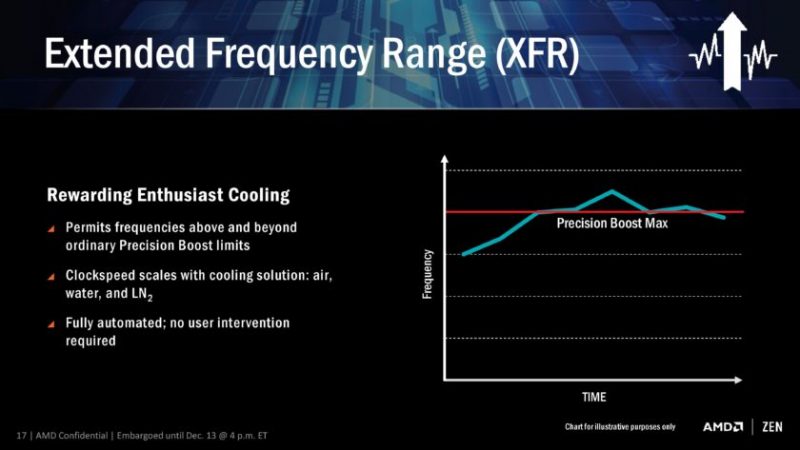Ką reiškia „Ryzen“ procesorių pavadinimuose esantis „X“? (Spėjimas)
Šią savaitę sužinojome, kiek kainuos trys sparčiausi „Ryzen“ procesoriai. Visi iškart pastebėjo, kad du iš jų pavadinime turi „X“ ir už tai reikia nemažai sumokėti, o trečiojo procesoriaus be „X“ kaina mažesnė. Negana to ir TDP reitingas daug žemesnis (95 W vs 65 W), nors dažnis skiriasi nedaug.
„TechPowerUp“ ištraukė labai įdomią teoriją, ką ši „X“ galėtų reikšti. Spėjama, kad „X“ gali reikšti procesoriaus sugebėjimą automatiškai spartintis priklausomai nuo aušinimo teikiamų galimybių. Šią technologiją AMD vadina „eXtended Frequency Range“ (XFR).
Spėjimas atrodo gan logiškas, nes už „Ryzen 7 1700“ vos 100 MHz didesni dažnį turintis „Ryzen 7 1700X“ gavo net 30 W didesnį TDP. Jei procesorius galėtų automatiškai spartintis papildomas TDP jam tikrai praverstų.
Kaip efektyviai veiks XFR dabar niekas nežino, neaišku ir kiek aukštai procesorius galės save paspartinti. Bet ši technologija, jei sugebės bent dalinai prilygti rankiniam spartinimui, mažiau pažengusiems naudotojams tikrai patiks.


Geras navarotas, kaip tik man 😀
Sprendžiant pagal neaišku iš kur gautą Zen procesorių ženklinimo tvarką (galbūt tai google vertimas iš prancūziško CanardPC, nes ‘core’ išversta kaip ‘heart’)- aš kol kas spėju kad dauguma gaus XFR’u stipriai nusivilti. Kodėl? Nes tai, mano manymu, yra skirta tik vienam branduoliui. Įmetu čia visą šifruotę, bet realiai skaityti užtenka tik du paskutinius kodus:
2 : Indicates the generation of the prototype. 1 = First generation Engineering Sample (ES0) – 2 = Second generation Engineering Sample (ES1) – Z = Qualification Sample (QS). The latter are intended for end-users for validation and theoretically offer the same specifications as commercial models.
D : Platform. D = Desktop – S = Server – M = Mobile.
315 : Basic frequency. In the frequent case, 3.15 GHz.
1 : Revision number of the model, in the case of several different processors with the same basic frequency.
A2 : Arbitrary internal code related to the maximum TDP and the specifications required by the VRM. A2 / BA = 95W – AU / BB = 65W
M : Physical package. M = AM4 – V = SP3
8 : Number of physical cores (excluding GTS)
8 : An arbitrary value corresponding to the size of the cache. 8 = 4MB L2 + 16MB L3 – K = 2MB L2 + 8MB L3 – H = 16MB L2 + 64MB L3 – I = 3MB L2 + 16MB L3
E4 : Stepping of the heart. E4 = A-Step – F4 = B-Step
The code name is used to know the basic frequency of the CPU.
There are nevertheless numerous other important frequencies, not to
mention all those related to the integrated chipset and the operation of
the SoC (Uncore). AMD specifies Ryzen cores with 8 different frequencies. For our 2D3151A2M88E4 test processor , we find:
F_P0 : the base frequency. Here of 3.15 GHz.
By default and without Turbo mode, all processor cores will be clocked
at this load frequency and will operate with a linked supply voltage.
F_P1 : AMD also defines a second lower frequency / voltage pair, which causes a significant decrease in power consumption (TDP). In our case, our processor will be clocked at 2.70 GHz.
F_P2 : Last torque frequency / voltage guaranteed, which further limits the consumption. 2.20 GHz with the test CPU.
It is of course possible for the processor to operate at an
intermediate frequency between these different modes P0, P1 and P2, but
these three frequency / voltage pairs allow the embedded management
systems to automatically construct a curve with finer granularity by
extrapolation. As a reminder, Ryzen accepts a granularity of 25 MHz.
F_Min : AMD also specifies a minimum frequency. This is currently set at 550 MHz on Desktop versions.
F_Boot : When initialized at the start of the machine, the Ryzen are clocked much lower than their nominal base frequency (F_P0). On our previously cited test specimen: 2.20 GHz. This frequency generally corresponds to F_P2, but there are some exceptions. At the boot, the processor dialogs with the motherboard to ensure that it can supply the current required for the F_P0 mode. If this is not the case, the maximum frequency will be limited to F_P2.
This feature theoretically allows the creation of low-cost limited
motherboards that will accept only Quad Core models, for example. An advantage for large integrators like HP or Dell.
F_TMT
: Like all modern CPUs, Ryzen chips feature Turbo mode to increase
frequencies while remaining within the limits of reliability.
When all the cores are used simultaneously, the example CPU can go from
3.15 GHz to 3.30 GHz, provided that the temperature, TDP and power
consumption remain below the maximum allowed. More than F_P0, F_TMT is the most important frequency for multithreaded performance.
F_TST : When only one heart is used, the frequency can still rise. In our case up to 3.50 GHz. This information is sometimes found in the code name as “ 2D3151A2M88E4 _31 / 35″. It increases the performance of Single Thread applications, which is becoming increasingly rare today.
F_TMAX : AMD finally specifies a last Turbo frequency „Max“. It only applies when only one heart is used, such as F_TST. The difference ? F_TST is guaranteed in all cases while F_TMAX is not. It depends on several parameters such as temperature.
O as sakyciau gal ir neblogai jei tik 1 branguolys. Kodel ? Todel, kad dauguma zaidimu vistiek labiau remiasi vienu branduoliu o kitiems krenta tik dalinis kruvis, todel jei 1 dirbtu 4,5-4,8 o kiti ~4ghz butu visai neblogai.